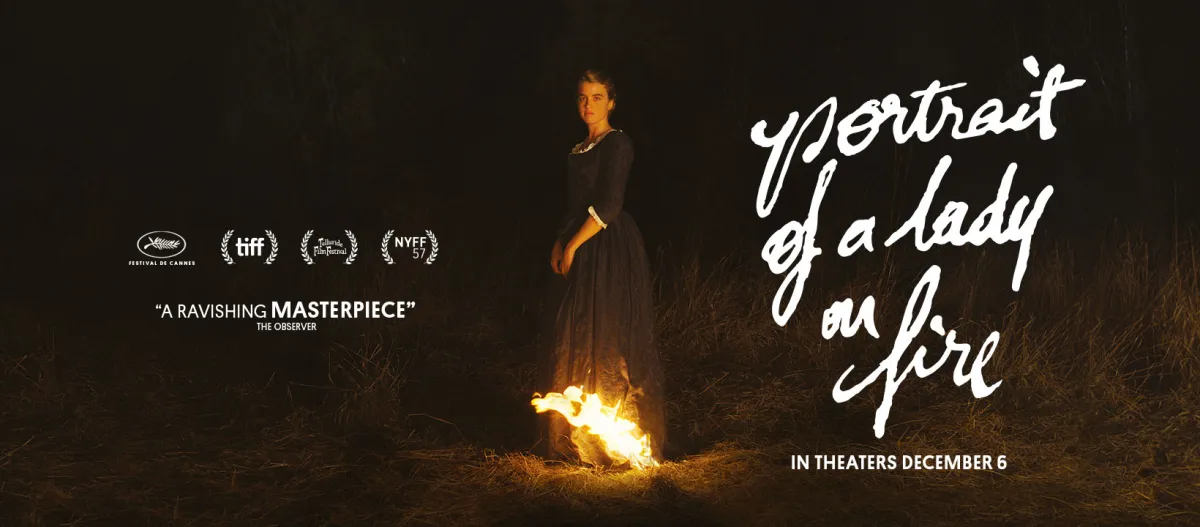Introduction:
“Portrait of a Lady on Fire,” directed by Céline Sciamma, stands as a beacon of contemporary French cinema, weaving a tale of forbidden love, artistic creation, and feminist undertones. Released in 2019, the film is set in 18th-century Brittany and revolves around the evolving relationship between a female artist and her enigmatic muse. In this extensive exploration, we delve into the film’s narrative intricacies, its visual and thematic brilliance, the performances of the cast, and the cultural significance that “Portrait of a Lady on Fire” holds in the realm of cinema.

Chapter 1: A Painterly Approach to Cinematic Storytelling
1.1 Marianne and Héloïse
The core narrative of “Portrait of a Lady on Fire” unfolds as Marianne, a portrait artist played by Noémie Merlant, is commissioned to paint a portrait of Héloïse, portrayed by Adèle Haenel. Héloïse, however, resists sitting for the portrait, leading to Marianne observing her subject by day and secretly painting by night. This clandestine artistic process becomes a metaphor for the hidden emotions and desires that permeate the film.
1.2 The Evolution of the Portrait
As the portrait takes shape, so does the relationship between Marianne and Héloïse. The film transcends traditional romance by exploring the nuances of love that go beyond societal constraints. The evolving portrait becomes a visual representation of the emotional and psychological layers of the characters, intertwining the act of painting with the exploration of personal identity and desire.

Chapter 2: Feminism and Autonomy
2.1 Feminist Exploration
“Portrait of a Lady on Fire” is a feminist exploration of autonomy and agency in a society that often subjugates women to prescribed roles. The characters navigate societal expectations, and the film reflects on the limitations placed on women in the 18th century. Sciamma’s direction invites viewers to consider the significance of personal agency and the pursuit of self-determination.
2.2 Female Gaze in Cinema
Céline Sciamma employs a distinct female gaze in her direction, shifting the narrative perspective from the male-centric norm. The film is not only about the romantic relationship between Marianne and Héloïse but also a broader commentary on the female experience. The female gaze becomes a narrative and visual tool, challenging cinematic conventions and offering a fresh perspective on love and desire.
Chapter 3: Visual Poetics and Symbolism
3.1 Cinematography and Lighting
The visual poetics of “Portrait of a Lady on Fire” are evident in the film’s cinematography, spearheaded by Claire Mathon. The use of natural light and carefully composed frames creates a painterly aesthetic that mirrors the artistic themes of the narrative. The cinematography becomes an integral part of the storytelling, capturing the emotional nuances of the characters and the atmospheric beauty of the coastal setting.
3.2 Symbolism in Art and Nature
Symbolism permeates the film, both in the art created within the narrative and in the natural elements that surround the characters. From the symbolic significance of the portrait itself to the recurring motif of fire, “Portrait of a Lady on Fire” employs visual metaphors that deepen the emotional impact of the story. The interplay between art and nature becomes a reflection of the characters’ internal struggles and desires.
Chapter 4: Performances and Character Dynamics
4.1 Noémie Merlant’s Marianne
Noémie Merlant delivers a captivating performance as Marianne, infusing the character with a blend of sensitivity, determination, and artistic passion. Merlant’s portrayal becomes a conduit for the audience to engage with the emotional journey of the artist as she grapples with professional duty and personal connection.
4.2 Adèle Haenel’s Héloïse
Adèle Haenel brings a profound depth to the character of Héloïse. Haenel’s performance captures the silent turmoil of a woman trapped within societal expectations, gradually finding her voice and agency. The chemistry between Merlant and Haenel is palpable, elevating the film’s central love story to a sublime and unforgettable experience.
Chapter 5: Narrative Complexity and Emotional Resonance
5.1 The Slow Unveiling of Emotions
“Portrait of a Lady on Fire” unfolds with deliberate pacing, allowing the emotions between the characters to simmer and gradually reveal themselves. The film avoids conventional dramatic beats, opting for a nuanced exploration of desire, longing, and connection. The slow burn of the narrative adds to the emotional impact, inviting viewers to immerse themselves in the complexities of love and intimacy.
5.2 Exploration of Loss and Memory
The film also delves into themes of loss and memory. Héloïse’s mother, a prominent figure in the narrative, is portrayed through the lens of grief and absence. The exploration of loss adds a layer of melancholy to the story, influencing the characters’ perceptions of love and shaping their individual journeys.
Chapter 6: Critical Acclaim and Cultural Impact
6.1 Cannes Film Festival Recognition
“Portrait of a Lady on Fire” premiered at the Cannes Film Festival in 2019, where it received the Best Screenplay award. The film’s recognition at Cannes marked its entry into the global cinematic consciousness, setting the stage for its widespread acclaim.
6.2 International Awards and Nominations
The film went on to receive numerous awards and nominations at international film festivals, solidifying its status as a cinematic gem. From accolades for its direction and screenplay to recognition for the performances of Merlant and Haenel, “Portrait of a Lady on Fire” garnered praise for its artistic and thematic achievements.
Conclusion: A Cinematic Triumph of Love and Art
In conclusion, “Portrait of a Lady on Fire” stands as a cinematic triumph that transcends the confines of traditional romance. Céline Sciamma’s direction, coupled with breathtaking performances and a narrative that explores the complexities of love and identity, creates a film that is both visually stunning and emotionally resonant. “Portrait of a Lady on Fire” not only enriches the canon of LGBTQ+ cinema but also contributes to the broader dialogue on love, autonomy, and the power of the female gaze in storytelling.
Film Evaluation: “Portrait of a Lady on Fire” is a rare cinematic gem that combines visual splendor with emotional depth. Céline Sciamma’s directorial finesse, coupled with outstanding performances, crafts a film that invites audiences into a world where love and art intersect in the most profound and affecting ways. In the tapestry of cinematic achievements, “Portrait of a Lady on Fire” stands as a beacon of storytelling artistry and a celebration of the transformative power of both love and art.


